Comprehensive Guide to Orthodontics: Achieving a Perfect Smile
Orthodontics is a specialized branch of dentistry that focuses on diagnosing, preventing, and treating misaligned teeth and jaws. Through various corrective techniques, orthodontic treatments help patients achieve optimal dental alignment, contributing to both improved aesthetics and functionality. This guide will explore the key aspects of orthodontic care, its benefits, common treatments, and what patients can expect during the process.
What Is Orthodontics?
Orthodontics involves correcting teeth and jaw alignment issues, commonly referred to as malocclusions, or bad bites. These can include crowded teeth, overbites, underbites, crossbites, open bites, and other alignment problems that affect the appearance and function of the teeth and jaws.
The Importance of Orthodontic Treatment
- Improved Oral Health: Misaligned teeth can make it difficult to clean properly, increasing the risk of tooth decay, gum disease, and other oral health issues. Orthodontics helps create a healthier bite, making it easier to maintain good oral hygiene.
- Enhanced Appearance: One of the primary reasons people seek orthodontic treatment is to improve their smile. Straight teeth are often considered more attractive, boosting self-confidence and overall facial aesthetics.
- Better Functionality: Correcting misaligned teeth can improve chewing and speech. Orthodontic care ensures that teeth meet properly, preventing excessive wear and tear on the enamel and reducing strain on the jaw joints.
- Prevention of Future Issues: Left untreated, alignment problems can worsen over time. Early intervention through orthodontics can prevent more severe complications, such as jaw pain, headaches, and uneven wear on the teeth.
Common Orthodontic Treatments
- Braces
- Braces are the most common type of orthodontic treatment. They consist of metal brackets attached to the teeth, connected by wires and rubber bands. The dentist periodically adjusts the wires to gradually move the teeth into the desired position.
- Braces are effective for treating a wide range of dental issues, from mild to severe misalignments.
- Invisalign
- Invisalign is a popular alternative to traditional braces. This treatment uses a series of clear, removable aligners that are custom-made to fit the patient’s teeth. The aligners gradually shift the teeth into their correct positions.
- Invisalign is often preferred by adults and teens because of its discreet appearance, as the aligners are nearly invisible.
- Retainers
- After the removal of braces or Invisalign, patients are often required to wear retainers to maintain the new position of their teeth. Retainers can be removable or fixed, depending on the patient’s specific needs.
- These devices help ensure that teeth do not revert to their previous misalignment.
- Palatal Expanders
- For children whose upper jaw is too narrow, a palatal expander can be used to widen the jaw. This allows for proper alignment of the teeth and creates more space, preventing crowding and other alignment issues as the child grows.
- Orthognathic Surgery
- In severe cases of misaligned jaws, orthognathic surgery may be necessary. This surgical procedure repositions the jaws to correct skeletal irregularities that cannot be addressed with braces or aligners alone.
The Orthodontic Process
- Initial Consultation: The process begins with a thorough consultation, during which the orthodontist evaluates your dental and jaw alignment through physical exams, X-rays, and impressions. The orthodontist will discuss the treatment options and develop a personalized plan.
- Placement of Braces or Aligners: If braces are chosen, they are bonded to the teeth, and the archwire is placed. For Invisalign, custom aligners are created based on a digital scan of the teeth.
- Regular Adjustments: Patients with braces typically visit the orthodontist every 4-6 weeks for adjustments. Invisalign patients change their aligners every 1-2 weeks, with periodic check-ups to monitor progress.
- Treatment Duration: The duration of orthodontic treatment varies depending on the complexity of the case. For mild cases, treatment may last about 12 months, while more severe cases can take 2-3 years.
- Retainers: After the braces or aligners are removed, retainers are prescribed to maintain the new tooth alignment. These may be worn full-time at first and gradually reduced to nighttime wear.
Benefits of Orthodontic Treatment
- Aesthetic Benefits: Orthodontics can greatly enhance a patient’s smile by correcting crooked teeth, gaps, and bite issues. A well-aligned smile contributes to a more attractive and confident appearance.
- Health Benefits: Properly aligned teeth are easier to clean, reducing the risk of plaque buildup, cavities, and gum disease. A correct bite also prevents wear on the teeth and strain on the jaw.
- Functional Benefits: Orthodontic care improves the ability to chew and speak properly. A well-aligned bite ensures that the teeth function efficiently, reducing the risk of long-term damage.
- Psychological Benefits: Many patients report improved self-esteem and confidence after completing their orthodontic treatment. A beautiful, healthy smile can have a positive impact on social and professional interactions.
Is Orthodontics Right for You?
Orthodontic treatment is suitable for individuals of all ages. Early intervention is often recommended for children as their jaws are still developing, making it easier to correct issues. However, adults can also benefit from orthodontics, with modern treatments like Invisalign offering discreet options for those concerned about appearance.
Conclusion
Orthodontics plays a vital role in achieving a beautiful, healthy smile by addressing tooth and jaw alignment issues. Whether through braces, Invisalign, or other corrective methods, orthodontic treatments offer long-lasting benefits for oral health, function, and aesthetics. If you’re considering orthodontic treatment, consult with an experienced orthodontist to explore the options that are best suited for your needs. With the right care plan, you can enjoy the confidence that comes with a well-aligned and radiant smile.


